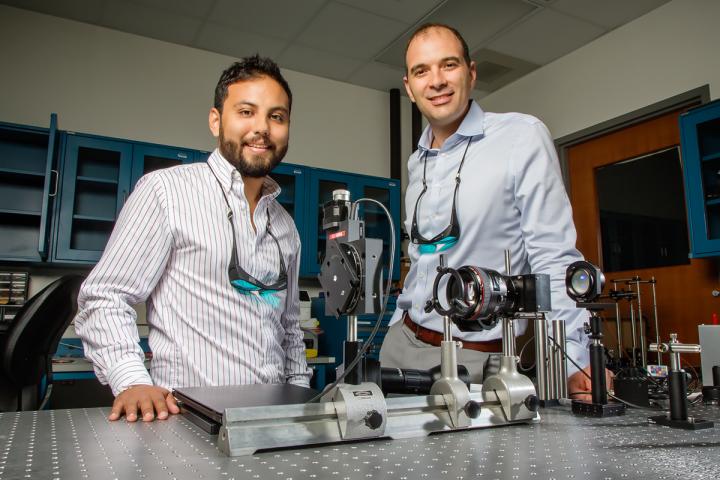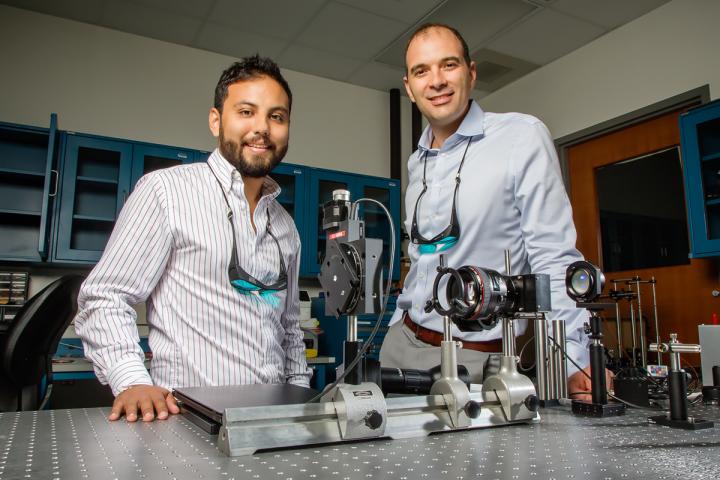
Credit: Photo by L. Brian Stauffer.
CHAMPAIGN, Ill. — By mimicking the eye of the mantis shrimp, Illinois researchers have developed an ultra-sensitive camera capable of sensing both color and polarization. The bioinspired imager can potentially improve early cancer detection and help provide a new understanding of underwater phenomena, the researchers said.
"The animal kingdom is full of creatures with much more sensitive and sophisticated eyes than our own," said Viktor Gruev , a University of Illinois professor of electrical and computer engineering and co-author of the new study. "These animals perceive natural phenomena that are invisible to humans.
"Polarization of light – that is, the direction of oscillation of light as it propagates in space – is one such example. While most of us are familiar with polarized sunglasses, which simply remove glare, many animals use polarized vision as a covert communication channel, to find food, or even to navigate by sensing polarization patterns in the sky."
The mantis shrimp, considered one of the best hunters in shallow waters, possesses one of the most sophisticated eyes in nature. Compared with human vision, which has three different types of color receptors, the mantis shrimp has 16 different types of color receptors and six polarization channels, Gruev said.
"These organs not only surpass the sensitivity of our own visual systems, they also capture more visual information, using less power and space, than today's most sophisticated, state-of-the-art cameras," he said.
See a video of describing the study on YouTube.
Gruev and graduate student Missael Garcia led an effort to replicate the shrimp's visual system using some basic physical concepts.
They report their findings in the journal Optica.
"Nature has devised materials such that different colors of light penetrate at different depths," said Gruev, who also directs the Biosensors Lab at Illinois. "If we shine a blue laser and a red laser on the tip of our finger, we can only observe the red light on the other side of the finger. This is because the red light can penetrate deeper in the tissue."
"Nature has constructed the mantis shrimp eye in such a way that photosensitive elements are vertically stacked on top of each other," Gruev said. This stacking allows for absorption of shorter wavelengths, such as blue light, in the shallow photoreceptors and red light in the deeper receptors. The photoreceptors are organized "in a periodic fashion at the nanoscale that allows them to also 'see' the polarized properties of light," he said.
"The same laws of physics that apply to the mantis visual system also apply to silicon materials, the material used to build our digital cameras" Garcia said. "By stacking multiple photodiodes on top of each other in silicon, we can see color without the use of special filters. And by combining this technology with metallic nanowires, we effectively have replicated the portion of the mantis shrimp visual system that allows it to sense both color and polarization."
This unique combination of silicon photodetectors and nanomaterials allowed the Illinois research team to create a point-and-shoot color-polarization camera. The applications for such cameras are wide-ranging, from early cancer detection to monitoring changes in the environment to decoding the covert communication channels that many underwater creatures appear to exploit, the researchers said.
In a previously published study by Gruev, a bioinspired polarization sensor fitted to a colonoscope could detect the disordered nature of cancerous cells in the human colon.
"By mimicking the mantis shrimp visual system, we have created a unique camera that can be used to improve the quality of our lives," Gruev said. "The notion that we can detect early formation of cancer is what is driving this research forward. The cost of this technology is less than $100, which will enable quality health care in resource-limited places around the world."
###
Gruev also is affiliated with the Beckman Institute for Advanced Science and Technology at the U. of I.
The National Science Foundation and the Air Force Office of Scientific Research supported this study.
Editor's notes:
To reach Viktor Gruev, email [email protected].
The paper "Bio-inspired color-polorization imager for real-time in situ imaging" is available online and from the U. of I. News Bureau.
DOI: doi.org/10.1364/OPTICA.4.001263
Media Contact
Lois Yoksoulian
[email protected]
217-244-2788
@NewsAtIllinois
http://www.illinois.edu
Related Journal Article
http://dx.doi.org/10.1364/OPTICA.4.001263





